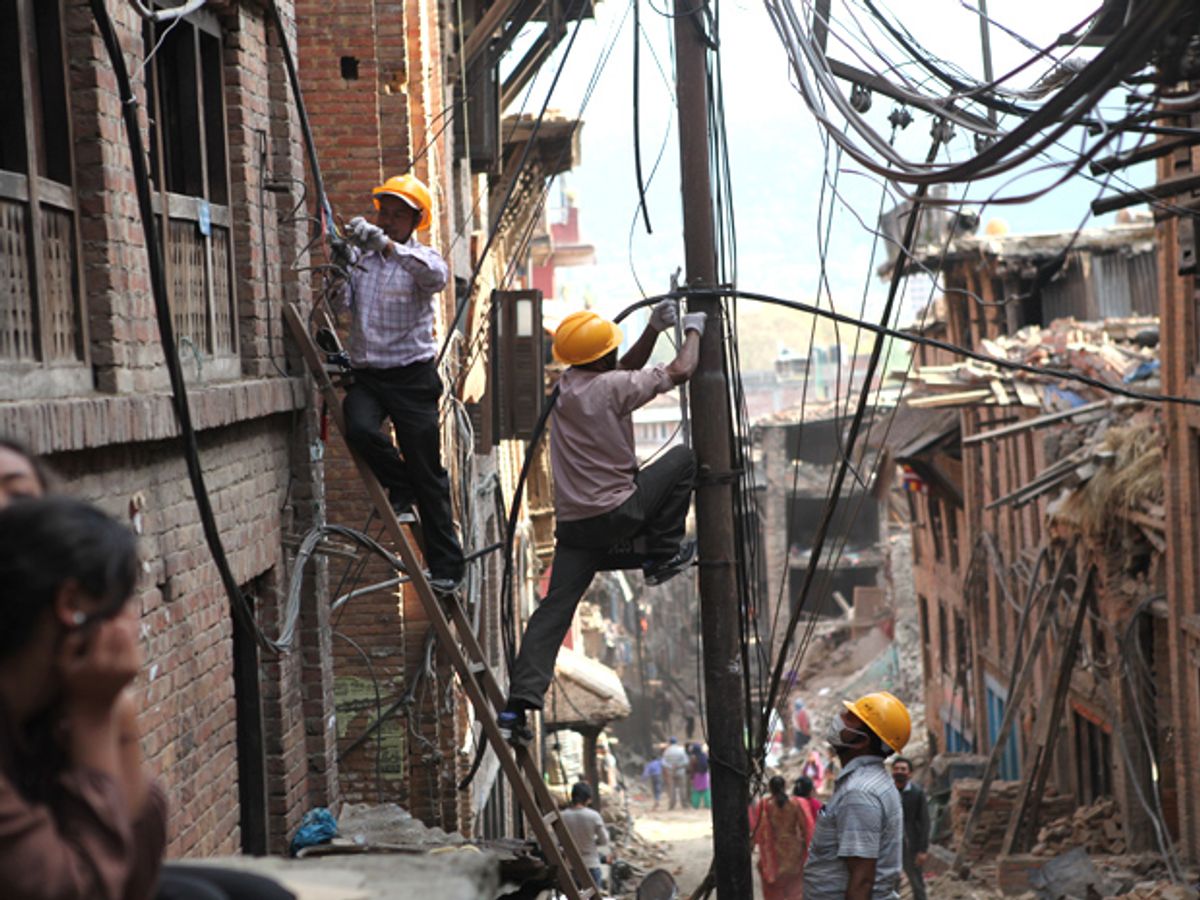The Kathmandu-based República online news service reported last week that over a dozen hydropower facilities were significantly damaged by last month's earthquake and were not operating. The affected plants’ combined capacity of roughly 150 megawatts (MW) represents about one-fifth of Nepal’s total power supply—which is 93 percent hydropower—but the damage may not be long-lasting according to state utility Nepal Electricity Authority (NEA).
NEA told República that Nepal's remaining hydropower plants and about 210 MW of imported power from India was enabling it to distribute about 564 MW total. And its 144-megawatt Kaligandaki hydroelectric power station—Nepal’s largest—is not on the list of damaged projects. A 27 April report from industry news source Hydroworld had initially raised concerns about Kaligandaki, citing local news sources.
Sher Singh Bhat, NEA’s deputy managing director, told República that some of the most severe damage from the Magnitude 7.8 quake was at NEA’s 10 MW Sunkoshi Hydropower Project, where “severe leakage” was observed. At the same time, some damaged plants could keep running, such as NEA’s 60 MW Kulekhani project was operating in spite of cracks that opened at the top of its dam.
Bhat noted that other damaged projects could be fixed “within weeks” -- once workers and heavy equipment operators became available. These include the 24 MW Trishuli plant, where cracks opened in the “crest” of a reservoir and landslides destroyed the workers’ quarters; another 14 MW plant downstream at Devighat can only run after Trishuli restarts.
More serious damage was wrought upstream of the Trishuli plant at the construction works of the 60 MW Upper Trishuli 3A project. A landslide killed four employees at the site and caused “severe” damage to tunnels and a suspension bridge.
Nepal’s biggest independent hydropower project—the 45 MW Upper Bhotekoshi plant—was immediately shut down after being struck by boulders wrought loose from overlying cliffs. Narendra Prajapati, CEO of Bhotekoshi Power Company, told República that the penstock pipe that feeds water to Upper Bhotekoshi’s turbines was damaged and they assume that its generators had been flooded as a result.
While Nepal’s 150 MW of idled capacity sounds small by the standards of developed industrial economies, the impact of any loss in power supply is massive for Nepal because the country is already vastly underpowered. Power outages are a daily reality, even in Kathmandu.
NEA’s latest Load Shedding schedule is one of the standard links atop every page at MyRepública.com, telling readers how electricity supplies will shape their day much like a daily weather report. On Saturday 25 April NEA expected to shut off power in Kathmandu from 6-8 am, and then again for another four hours in the afternoon. The schedule warns, however, that load shedding could shift forward or back by one hour depending on conditions.
In recent years Nepal has been accelerating hydropower developments. At least one of which has been set back by the earthquake: the 111-MW Rasuwagadhi hydropower dam under construction by Chinese hydropower giant Three Gorges Corporation. Two Chinese workers were killed in the earthquake, and the dam was “severly damaged” according to Three Gorges. Chinese military helicopters rescued 280 Chinese workers from the site within days of the quake, while the New Yorker reported that Three Gorges’ 350 Nepali workers were “left to walk” out of the remote region.
Much more hydropower investment is slated for Nepal. Three Gorges has contracts to build two other projects in Nepal, including the comparatively massive $1.6-billion, 750-MW West Seti project approved by Kathmandu less than two weeks before the April earthquake. And Indian-financed megaprojects in the development pipeline —including a pair approved last year worth $2.4 billion—would add another 1,800 MW to Nepal’s power generating capacity.
It is important to note that these Himalayan heavyweights are financing Nepalese projects primarily as a source of power for their own economies. Such projects’ benefit to Nepal is more financial than electrical. For example, all but 12 percent of the 900 MW to be generated by the Indian-financed Upper Karnali project is to be exported.
The New Yorker raised another potential caveat to the hydropower-filled future Nepal has been developing: the risk that hydropower megaprojects could induce future earthquakes. Human-induced seismicity is a real liability associated with a growing number of energy projects, including oil and gas production, geothermal energy, and—in some cases—hydropower projects.
However, for hydropower, it is the shifting weight of water stored in reservoirs that has been linked to earthquakes such as 7.9 Sichuan quake that devastated central China in 2008. Many of the Nepalese projects rely on a run-of-river design that exploits its rivers’ strong, steady currents rather than storing lots of water behind big dams.
A real and longer-term threat is the melting of Himalayan glaciers, which threatens to increase flooding and landslides and in the longterm could reduce Nepal’s raging rivers to trickles. Nepal lost over a quarter of its glacier mass between 1980 and 2010, according to a 2014 report from the Kathmandu-based International Centre for Integrated Mountain Development.
How future melting will play out for river flows is, however, unclear. The same research center reported in 2013 that glacial melting in the Himalayas could peak by 2070, thus preserving river flows in key watersheds.
Peter Fairley has been tracking energy technologies and their environmental implications globally for over two decades, charting engineering and policy innovations that could slash dependence on fossil fuels and the political forces fighting them. He has been a contributing editor with IEEE Spectrum since 2003.



